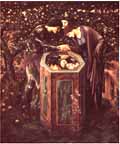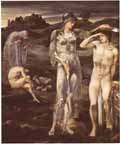The first and last paintings of the Perseus Series by Edward Burne-Jones oppose each other in terms of their content, composition and color-scheme and thus effectively demonstrate the narrative progression in William Morris's version of the classical myth. The Calling of Perseus illustrates two events in Morris's poem, using a proto-cinematic cut from one visual plane to another. The background shows Athena, disguised as an old woman, approaching Perseus who compresses himself in a pose of despondent melancholy. The bleakness of the untested, unsure hero seeps into Burne-Jones's depiction of the landscape in cool, muted colors. The painter chooses to make this color scheme pervasive and eschews Morris's revelatory lightening when Athena removes her disguise: "the white moon risen high / Burst from a cloud, and shone out gloriously."
Burne-Jones also changes Morris's characterization of Athena during her transfiguration from old woman to goddess. He leaves out some of the iconography mentioned by Morris — the "fair breastplate" — and adds a mirror which Perseus will use to kill the Medusa. Traditionally Athena presents Perseus with a polished shield in which he can see the Medusa, but here she rather impractically gives him an ordinary hand mirror. Burne-Jones has here significantly diminished the martial quality of this mythic scene. Perseus does not commence his journey as a preformed hero: he is unsure, depressed and, in Burne-Jones's depiction of him in the foreground, rather feminine. While Athena towers commandingly over Perseus, Burne Jones diminishes her masculine, warlike attributes — her helmet could almost be a hood, she lacks full armor (both for herself and in her gift to Perseus) and her transparent dress reveals her body. The strange qualities of the surrounding landscape penetrate even the goddess, as her body, especially her legs, shares the pervasive blue tint. Athena, here, bears a small resemblance to the enthusiastic helper for the hero, as described in Morris's poem.
Burne-Jones does not depart as drastically from the Morris poem in the final scene of the Perseus series as he does in the initial one. At the end of the heroic quest, the strange, dream-like landscape has disappeared; in its place, Burne-Jones creates a pleasant, enclosed garden, which frames the two lovers in natural greenery. Perseus, as a triumphant hero, stands fully armored and exudes a much more masculine presence than he has previously. The couple's heads partially obscure the powerful female here (as opposed to Athena, looming over Perseus in the first scene). Andromeda, with her submissiveness and beauty, contains the danger which the Medusa poses as a feminine challenge to Perseus's authority. The final painting gives a sense of narrative and visual closure to a series dealing with classical heroism, since it moves away from the otherworldly landscape and feminine dominance of the paintings that preceded it.
Questions
In "The Calling of Perseus," what effects does Burne-Jones create by compressing two events from the poem into one painting? What does this tell us about the capabilities of textual illustration?
Unlike Burne-Jones, Morris does not expressly set the last scene in a garden. Why do you think the painter chose this setting?
How does the presence of a female nude in "The Rock of Doom" and "The Doom Fulfilled" affect the painting? How is the female nude different from the male nude in "The Calling of Perseus"?
How is Morris's poetic description of the battle between Perseus and the sea monster different from Burne-Jones's visual adaptation?
Related Material
- The Beautification of Ugliness in Burne-Jones's Perseus Cycle
- Perseus and the Sea Nymphs: Burne-Jones and his Frustration
- Originality in Burne-Jones' The Death of Medusa
- Chivalry and the psychology of love in Edward Burne-Jones's Perseus and Andromeda
- Gender and Voyeurism in the Burne-Jones Perseus Cycle
Bibliography
Wood, Christopher. The Pre-Raphaelites. New York: Studio/Viking, 1981.
Last modified 12 June 2020

